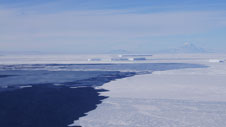Major Funding for University of Otago-Led Sea Ice Research
Project is among the first Deep South Challenge funding allocations that will see over $9 million spent on six projects over four years
 Satellite observations show that the maximum total extent of sea ice around the Antarctic has been increasing slowly over the past three decades.Image courtesy of the University of OtagoUniversity of Otago physicist Associate Professor Pat Langhorne has been allocated $1.9 million by the Deep South National Science Challenge to lead a research project on Antarctic sea ice, which is a key element in the global climate system.
Satellite observations show that the maximum total extent of sea ice around the Antarctic has been increasing slowly over the past three decades.Image courtesy of the University of OtagoUniversity of Otago physicist Associate Professor Pat Langhorne has been allocated $1.9 million by the Deep South National Science Challenge to lead a research project on Antarctic sea ice, which is a key element in the global climate system.
The Deep South Challenge is one of 11 Ministry of Business, Innovation and Employment-funded challenges aimed at taking a more strategic approach to science investment.
Associate Professor Langhorne’s project, “Targeted observation and process-informed modelling of Antarctic sea ice”, is among the first Deep South funding allocations that will see over $9 million spent on six projects over four years.
The presence of Antarctic sea ice maintains cold conditions that help sustain Antarctica’s ice sheets, and it affects the rate of global warming by influencing ocean heat uptake in the Southern Ocean, says Associate Professor Langhorne.
“Antarctic sea ice has a significant influence on both the ocean and atmospheric components of the climate system, and variability in sea ice extent is coupled with the occurrence of weather systems over New Zealand.
“While it is understood that growth and decay of sea ice is driven by a range of processes, a paucity of observations has meant these drivers are poorly understood,” she says.
Associate Professor Langhorne says that satellite observations show that the maximum total extent of sea ice around the Antarctic has been increasing slowly over the past three decades, a behavior superficially at odds with “global warming”.
“Earth System Models (ESMs), a kind of global climate model that seeks to simulate key physical, chemical and biological processes, currently cannot faithfully reproduce these recent trends in sea ice coverage, particularly their varying regional response,” she says.
Related article: Better Forecasts for Sea Ice under Climate Change
Through preparation and modelling work in New Zealand, and field experiments on the ground in Antarctica, Professor Langhorne’s project aims to focus on the inner and outer margins of the Antarctic sea ice cover where it has been observed to grow and recede fastest.
Ice shelves supply very cold water that increases growth near the continent, while the mechanical energy of ocean surface waves breaks-up the sea ice near the ice edge.
“Our study will increase our understanding of these drivers of growth and decay, and connect with complementary national and international activities. These discoveries will be incorporated into the sea ice module used by the first New Zealand Earth System Model, which is being developed by NIWA as another of the six projects.”
Associate Professor Langhorne will be collaborating with colleagues at NIWA, University of Canterbury, Callaghan Innovation, Victoria University of Wellington, York University (Canada), University of Washington (USA), and University of Texas at San Antonio (USA).
